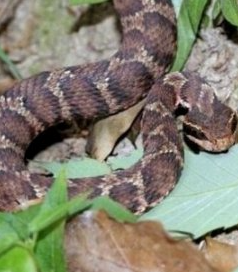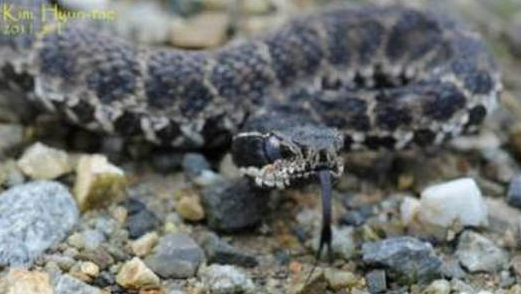Snake Facts: Mamushi-Gloydius blomhoffii

The Mamushi or Japanese Mamushi (Gloydius blomhoffii) is a venomous pitviper snake species found in Japan, China, and Korea. The claims that these snakes also occur in the Ryukyu Islands remain unconfirmed.
It is considered the most common snake in Japan and one of the most dangerous to humans. There are 4 subspecies usually recognized by scientists (see subspecies below).
The mamushi is found in a variety of habitats such as open woodland, meadows, swamps, marshes, rocky hillsides, and montane rock outcroppings. These snakes are also known by other common name such as Japanese moccasin or Japanese pit viper, Qichun snake, soil snake or soil viper in China and Salmusa or Salmosa in Korea.
Adult mamushi snakes usually reach a length of about 12 to 25 inches (28 to 68 cm) with the longest specimen ever recorded reaching an astounding 36 inches (91 cm). They have a moderately thick body with a short tapering tail.
Their coloration consists of a reddish-brown, pale gray, or yellow-brown background covered with a number of irregularly-shaped darker blotches on the back and sides. These blotches have black borders and very often a lighter colored center.
Like most pit vipers their head distinctively triangular covered in a dark brown almost black color, with the sides of the head being pale-gray or beige. Mamushi eyes have vertical elliptical pupils and are medium sized. Their dorsal scales are keeled. The mamushi has a gray underside covered with long white stripes.
The Japanese mamushi is very similar in appearance to the American cottonmouth (Agkistrodon piscivorus) and the copperhead (Agkistrodon contortrix) and for a long time it was classified in the same taxonomic group the Agkistrodon genus.
Subspecies / Taxonomy / Etymology
The species specific name, blomhoffii, was given in honor of the director of the Dutch trading colony in Nagasaki, Japan from 1817 to 1824, Jan C. Blomhoff.
These are the four recognized subspecies for the Mamushi snake.
Japanese mamushi (Gloydius blomhoffii blomhoffii – H. Boie, 1826) – Found in Japan, this includes most of the smaller islands.
Short-tailed mamushi (Gloydius blomhoffii brevicaudus – Stejneger, 1907) – Found in the Korean Peninsula and Northeastern China.
Tung Ling mamushi (Gloydius blomhoffii dubitatus – Gloyd, 1977) – It’s found only in a restricted area the Hebei Province, China.
Yangtze mamushi (Gloydius blomhoffii siniticus – Gloyd, 1977) – Found only in China from Shandong, Anhui, JiangSu provinces, south to eastern Sichuan and the Ch’ang Chiang Basin, Hunan and Jiangxi.
Venom / Bite
The mamushi is a venomous snake and its venom is mostly comprised of haemolytic toxins but it also has some neurotoxins and anticoagulants.
Their venom as a component very similar to that of the beaded lizard (Heloderma horridum) a close relative of the gila monster (Heloderma suspectum) found in North America.
Together the Okinawan habu and the mamushi are considered the most venomous and dangerous snakes found in Japan. Their venom potency and effects varies very little geographically with an intraperitoneal LD50 value in mice ranging from 0.3 mg/kg to 1.22 mg/kg.
The Mamushi bites around 2 to 3 thousand people every year in Japan alone, with the most severe bites requiring intensive care. Even though their bite isn’t usually fatal on average about 5 to 10 bite victims eventually die every year.
The mamushi venom causes the victims tissues to liquify, sometimes leading to skin necrosis. Toes and fingers are the most frequently bitten body parts with severe swelling causing the compression of peripheral arteries.
Some reports also account for renal failure, muscle degeneration, palsy, peripheral neuropathy, visual disturbances, disseminated intravascular coagulation and hemolysis and even miscarriage in pregnant women.
Effective antivenoms are manufactured in both Japan and China, with treatment protocol usually consisting on relaxation incisions and the injection of the mamushi antivenom.
Usually bite victims require about a week of hospitalization, followed by another 4 weeks of out-patient treatment, while a full recovery may take several months.

Diet / Feeding
The mamushi feeds mainly on small mammals such as rodents, frogs and small birds but also lizards and insects.
These venomous pit vipers are ambush predators hunting by day as well as at night, using their natural camouflage to hide in the leaf litter or vegetation.
They have heat sensitive pits that allow them to locate their warm-blooded prey in the darkness. The mamushi is very often found in and around farms and farmland, because of the number of rodents commonly found there.
They kill their prey by injecting them with their potent venom through a pair of hypodermic needle like fangs.
Reproduction
The mamushi is a viviparous species, meaning they are live-bearing snakes giving birth to live young, unlike other snakes that lay eggs. The females also have sperm storage pockets so they are capable of producing young as much as 3 years after copulation takes place.
Mamushi females will sometimes skip reproduction for 1 or more years. Gravid females come together at gestation sites in the summer and fall and give birth to 2 to 13 younglings in August and October.
The average litter is about 6 or 7 neonates, however the longer the female larger the litter and longer the neonates will be. While females reach sexual maturity at 40 to 45 cm in length males become mature at about 3 years of age and a body length of about 40 cm.
Conservation / Threats
The mamushi isn’t listed in the IUCN red list. However, in more recent years, several thousands have been exported from China to Japan to use on folk medicine and whiskey making. This high rate of collection is obviously taking its toll on the mamushi population in the wild.